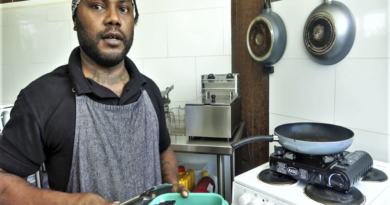Continuing the Knowledge of ‘Lata’ – The First Polynesian Voyager to Build and Sail a ‘Vaka’ To Distant Islands
BY ALEX DADAMU
IN the far eastern region of the Solomon Islands in Temotu Province, there situated the remote isles of Taumako, which is part of the Duff group of islands and is one of eight Polynesian islands in the Melanesian region of the Solomon Islands.
The Polynesian group of people in Taumako Island have today kept a century-old knowledge and practice of constructing ‘Vaka’ canoe and they possess great navigational skills.
The genuinely ancient practice of voyaging and constructing ‘Vaka’ canoe was revived by ‘Lata’ – the Polynesian voyager who was the first to try and revive his ancestors’ skills in using only ancient materials, methods, designs, and tools to build voyaging canoes and navigate, according to historical accounts being told.
Hawaiian based sailor, and anthropologist, Dr. Mimi George said that in Taumako – “people can show you where Lata was born, where ‘TeUbe’ bird showed Lata the right tree to use, where Lata moored the ‘TePuke’ to stones on the reef, where Lata sharpened his ‘adze’ blades, Lataʻs stone chair, where Lata sailed his ‘TePuke’ out into the open sea, etc.
But the Taumako descendants of Lata are trying to keep Lataʻs knowledge alive and according to Duff Islander, Dr. Simon Salopuka, Founder of Vaka Valo Association (VVA), he said when Master Navigator, Te Aliki Kruso Kahia Kaveia passed on in 2009, there were not many Taumakoans who have mastered the knowledge of traditional navigation.
Dr. Salopuka who initiated the ‘Vaka Valo Association (VVA)’ in 2014 said one of the reasons why he founded the Association was to find out if there were still Taumakoan people who would be able to build a ‘TePuke’ canoe and sail it using traditional navigation technique after Te Aliki Kaveia passed on.
He added the Vaka Valo Association was created because there was no leadership and it was quite difficult to accomplish any community project as what happens to Vaka Taumako Project started by Master Navigator,Te Aliki Kaveia.
Dr. Salopuka told Tourism Media Solomon Islands that after doing his brief assessment, he found out that there were three of Te Aliki Kaveia’s students who could build a ‘TePuke’ and ‘Tealolili’ canoe and sailed it using traditional navigational knowledge.
Dr. Salopuka revealed that during the four years he spend at Taumako islands (2014 to 2018), he coordinated the construction of one ‘Tealolili’, one ‘Tealo Uwa Uwa’, and two ‘TePuke’ canoes.
Unfortunately, the ‘Vakas’ canoes were destroyed by a cyclone in February last year (2020) and therefore they were not able to continue to sail and train the youths of Taumako on Traditional navigational methods. A Proa (an outrigger design canoe) is currently in construction in Hawaii by a company called, ‘Ocean People Inc., according to Dr. Mimi George.
“The boat is a 38-foot (12.3 meters) long proa which will have a 12-passenger capacity, as well as a 1 to 1/2-ton capacity refrigerated fish hold.
“They will be able to make money hauling passengers, also catching fish and keeping them cold during the 1 to a 2-day delivery trip to the relatively heavily-populated district center,” Ocean People Inc.,” a statement by Ocean People Inc. on their website repeatedly confirmed.
Dr. Mimi George further explained that the S.V. Lata will be a training vessel for VVA students to learn to sail a proa.
“The S.V. Lata will have a very efficient 14 horse-power diesel engine that will help make it an all-seasons vessel.
“The S.V. Lata is being built to qualify as a commercial vessel and will offer services as a charter vessel in Temotu. But also an asset to Temotu Province, which has no such vessel at this time, “Dr. Mimi said.
She reiterated that the VVA also aimed to build a Halevaka (canoe house) that will not only shelter ‘TePuke’ and other types of ‘Vaka o Lata’ Canoes but will be a place for the students to gather, learn and work.
“VVA also sees the S.V. Lata as a way to bring visitors as cultural tourism students to accommodations that the Halevaka can have.
“So the Lata School will be open to cultural tourist/students and that will bring some income to reduce costs/support programs for the Taumakoans.
“None of this can happen without reliable, local-controlled, transport. The S.V. Lata and the Halevaka (as a cultural school) will make it so much possible and practical,” Dr. Mimi said.



Very interesting and educational article .
This post will assist the internet users for creating new website or even a
blog from start to end.
Very good article!
We will be linking to this particularly great
post on our site.
Keep up the good writing.
I am now not positive where you are getting your information,
however
good topic. I must spend some time learning more
or understanding more. Thanks for excellent info I was on the lookout for this
information for my mission.
Hurrah, that’s what I was seeking for,
what a information! present here
at this webpage, thanks admin
of this web page.
This article is actually a nice one it assists new internet users, who are
wishing in
favor of blogging.
I was recommended this blog by my
cousin. I’m not sure whether this post is written by him as nobody
else know such detailed about my difficulty.
you’re amazing! Thanks!
Excellent post. I was checking continuously this blog and I’m impressed!
Extremely helpful info particularly the last part
I care for
such information much. I was seeking this particular information for
a very long time. Thank you and best of luck.